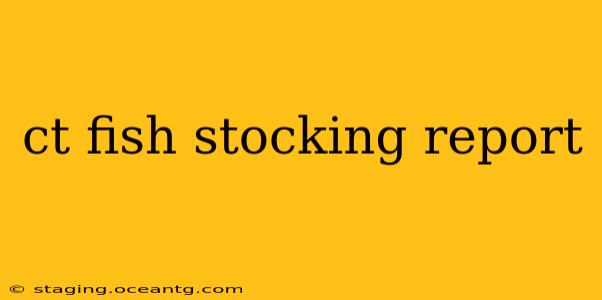Connecticut's Department of Energy and Environmental Protection (DEEP) diligently manages its diverse fish populations through a comprehensive stocking program. This report details the intricacies of this program, answering common questions and providing valuable insights for anglers and conservationists alike. Understanding the CT fish stocking report is crucial for anyone interested in the health and sustainability of Connecticut's fisheries.
What is the Connecticut Fish Stocking Program?
The CT fish stocking program is a vital component of the DEEP's fisheries management strategy. It involves the strategic introduction of various fish species into lakes, ponds, and rivers across the state. This isn't simply about increasing fish numbers; it's a carefully planned process designed to:
- Enhance recreational fishing opportunities: Stocking provides anglers with more opportunities to catch fish, boosting participation and enjoyment.
- Maintain or restore fish populations: In some cases, stocking helps to bolster dwindling populations affected by habitat loss, pollution, or natural fluctuations.
- Introduce new species: Strategically introducing new species (after careful consideration of ecological impacts) can diversify fishing opportunities and improve the overall ecosystem balance.
The program meticulously tracks the types and numbers of fish stocked, along with the specific locations. This data is publicly available and forms the basis of the CT fish stocking report.
Where can I find the CT Fish Stocking Report?
The official CT fish stocking report, including details on species, quantities, and locations, is typically accessible through the Connecticut DEEP website. Look for sections dedicated to inland fisheries or fishing regulations. The report may be updated periodically, so regular checks are recommended.
How often is the CT fish stocking report updated?
The frequency of updates to the CT fish stocking report varies. It's often updated seasonally or annually, reflecting the ongoing stocking activities. Checking the DEEP website regularly ensures access to the most current information.
What information is included in a typical CT fish stocking report?
A comprehensive CT fish stocking report usually includes:
- Species stocked: A detailed list of the fish species introduced, including trout (brown, rainbow, brook), bass (largemouth, smallmouth), and other species relevant to Connecticut's waters.
- Quantity stocked: The number of fish of each species released into each water body.
- Location of stocking: Precise locations (often identified by lake or pond name) where the fish were released.
- Date of stocking: The specific dates when the stocking events took place.
- Size of fish stocked: Information on the average size of the fish at the time of stocking. This helps anglers understand what to expect when fishing.
What types of fish are typically stocked in Connecticut?
Connecticut's stocking program focuses on species popular with anglers and those that contribute positively to the ecosystem. Common species include:
- Trout: Various trout species are frequently stocked, particularly in rivers and streams, to support fly fishing and angling activities.
- Bass: Largemouth and smallmouth bass are often stocked in lakes and ponds to improve bass fishing opportunities.
- Other species: Depending on the specific water body and management goals, other species such as catfish, sunfish, and pickerel might be included in the stocking program.
How does the DEEP decide which waters to stock?
The DEEP employs a data-driven approach to determine stocking locations. Factors considered include:
- Water quality: Only suitable waters that meet specific quality standards are considered for stocking.
- Habitat suitability: The presence of appropriate habitat (cover, food sources) is crucial for fish survival and growth.
- Fishing pressure: Areas with high angler use are often prioritized to maintain fishing opportunities.
- Ecological considerations: The potential impacts on existing fish populations and the overall ecosystem are carefully assessed.
What are the benefits of the CT fish stocking program?
The CT fish stocking program offers several key benefits:
- Enhanced recreational fishing: Provides more fishing opportunities for anglers of all skill levels.
- Economic benefits: Supports the local economy through tourism and related businesses.
- Conservation efforts: Helps to maintain and restore fish populations in various water bodies.
- Environmental education: Raises public awareness about fisheries management and conservation.
By understanding the information contained within the CT fish stocking report, anglers can make informed decisions about where and when to fish, contributing to the responsible and sustainable enjoyment of Connecticut's valuable fishing resources. Remember to always check the DEEP website for the most up-to-date information and regulations.
